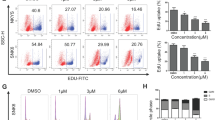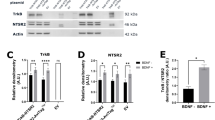Abstract
Neuroblastoma is the most common solid extracranial neoplasm in children and causes many deaths. Despite treatment advances, prognosis for neuroblastoma remains poor, and a critical need exists for the development of new treatment regimens. TNF-related apoptosis-inducing-ligand (TRAIL) induces cell death in a variety of tumors, but not in normal tissues. Moreover, TRAIL is nontoxic, making it a strong antitumor therapeutic candidate. We demonstrate that introduction of the TRAIL gene into neuroblastoma cell lines using an adenoviral vector leads to apoptotic cell death. RT-PCR and flow-cytometric analyses demonstrated that TRAIL's effect is mediated primarily via the TRAIL R2 receptor. As TRAIL can activate the nuclear factor-κB (NF-κB) signaling pathway, which can exert an antiapoptotic effect, we hypothesized that inhibition of NF-κB signaling may augment TRAIL's killing effects. TRAIL-mediated cell death was enhanced when neuroblastoma cells were simultaneously infected with a dominant-negative mutant of IκB kinase, a kinase essential for NF-κB activation. The combination of blockade of NF-κB signaling and expression of TRAIL induced apoptotic death in a greater proportion of SKNSH cells than did either treatment alone. Thus, concurrent inhibition of the NF-κB pathway and the induction of TRAIL-mediated apoptosis may become a useful approach for the treatment of neuroblastoma.
This is a preview of subscription content, access via your institution
Access options
Subscribe to this journal
Receive 12 print issues and online access
$259.00 per year
only $21.58 per issue
Buy this article
- Purchase on Springer Link
- Instant access to full article PDF
Prices may be subject to local taxes which are calculated during checkout








Similar content being viewed by others
References
Humpl T . Neuroblastoma. World J Urol. 1995;13:233–239.
De Bernardi B, Conte M, Nigro M, et al. Neuroblastoma: update on clinical aspects and therapy. Pediatr Med Chir. 1994;16:7–14.
Johnstone RW, Ruefli AA, Lowe SW . Apoptosis: a link between cancer genetics and chemotherapy. Cell. 2002; 108:153–164.
McGill G . Apoptosis in tumorigenesis and cancer therapy. Front Biosci. 1997;2:d353–d379.
Ashkenazi A, Dixit VM . Death receptors: signaling and modulation. Science. 1998;281:1305–1308.
Griffith TS, Broghammer EL . Suppression of tumor growth following intralesional therapy with TRAIL recombinant adenovirus. Mol Ther. 2001;4:257–266.
French LE, Tschopp J . The TRAIL to selective tumor death. Nat Med. 1999;5:146–147.
Griffith TS, Lynch DH . TRAIL: a molecule with multiple receptors and control mechanisms. Curr Opin Immunol. 1998;10:559–563.
Walczak H, Miller RE, Ariail K, et al. Tumoricidal activity of tumor necrosis factor-related apoptosis-inducing ligand in vivo. Nat Med. 1999;5:157–163.
Ashkenazi A, Dixit VM . Apoptosis control by death and decoy receptors. Curr Opin Cell Biol. 1999;11:255–260.
Griffith TS, Anderson RD, Davidson BL, et al. Adenoviral-mediated transfer of the TNF-related apoptosis-inducing ligand/Apo-2 ligand gene induces tumor cell apoptosis. J Immunol. 2000;165:2886–2894.
Li ZW, Chu W, Hu Y, et al. The IKKbeta subunit of IkappaB kinase (IKK) is essential for nuclear factor kappaB activation and prevention of apoptosis. J Exp Med. 1999;189:1839–1845.
Sanlioglu S, Luleci G, Thomas KW . Simultaneous inhibition of Rac1 and IKK pathways sensitizes lung cancer cells to TNFalpha-mediated apoptosis. Cancer Gene Ther. 2001;8:897–905.
Flick DA, Gifford GE . Comparison of in vitro cell cytotoxic assays for tumor necrosis factor. J Immunol Methods. 1984;68:167–175.
Fadok VA, Savill JS, Haslett C, et al. Different populations of macrophages use either the vitronectin receptor or the phosphatidylserine receptor to recognize and remove apoptotic cells. J Immunol. 1992;149:4029–4035.
Fadok VA, Voelker DR, Campbell PA, et al. Exposure of phosphatidylserine on the surface of apoptotic lymphocytes triggers specific recognition and removal by macrophages. J Immunol. 1992;148:2207–2216.
Thiagarajan P, Tait JF . Binding of annexin V/placental anticoagulant protein I to platelets. Evidence for phosphatidylserine exposure in the procoagulant response of activated platelets. J Biol Chem. 1990;265:17420–17423.
Raynal P, Pollard HB . Annexins: the problem of assessing the biological role for a gene family of multifunctional calcium- and phospholipid-binding proteins. Biochim Biophys Acta. 1994;1197:63–93.
Koopman G, Reutelingsperger CP, Kuijten GA, et al. Annexin V for flow cytometric detection of phosphatidylserine expression on B cells undergoing apoptosis. Blood. 1994;84:1415–1420.
Martin SJ, Reutelingsperger CP, McGahon AJ, et al. Early redistribution of plasma membrane phosphatidylserine is a general feature of apoptosis regardless of the initiating stimulus: inhibition by overexpression of Bcl-2 and Abl. J Exp Med. 1995;182:1545–1556.
Abe K, Kurakin A, Mohseni-Maybodi M, et al. The complexity of TNF-related apoptosis-inducing ligand. Ann NY Acad Sci. 2000;926:52–63.
Griffith TS, Chin WA, Jackson GC, et al. Intracellular regulation of TRAIL-induced apoptosis in human melanoma cells. J Immunol. 1998;161:2833–2840.
Karacay B, O’Dorisio MS, Summers M, et al. VIP receptor 1 (VPAC1) promoter targets the expression of a reporter gene to cerebellum and adrenal medulla in transgenic mice. Regul Pept. 2003;116:1–12.
Beg AA, Baltimore D . An essential role for NF-kappaB in preventing TNF-alpha-induced cell death. Science. 1996;274:782–784.
Chaudhary PM, Eby M, Jasmin A, et al. Death receptor 5, a new member of the TNFR family, and DR4 induce FADD-dependent apoptosis and activate the NF-kappaB pathway. Immunity. 1997;7:821–830.
Hopkins-Donaldson S, Bodmer JL, Bourloud KB, et al. Loss of caspase-8 expression in neuroblastoma is related to malignancy and resistance to TRAIL-induced apoptosis. Med Pediatr Oncol. 2000;35:608–611.
Yang X, Thiele CJ . Targeting the tumor necrosis factor-related apoptosis-inducing ligand path in neuroblastoma. Cancer Lett. 2003;197:137–143.
Teitz T, Wei T, Valentine MB, et al. Caspase 8 is deleted or silenced preferentially in childhood neuroblastomas with amplification of MYCN. Nat Med. 2000;6:529–535.
Eggert A, Grotzer MA, Zuzak TJ, et al. Resistance to tumor necrosis factor-related apoptosis-inducing ligand (TRAIL)-induced apoptosis in neuroblastoma cells correlates with a loss of caspase-8 expression. Cancer Res. 2001;61:1314–1319.
Van Antwerp DJ, Martin SJ, Kafri T, et al. Suppression of TNF-alpha-induced apoptosis by NF-kappaB. Science. 1996;274:787–789.
Lipton SA . Janus faces of NF-kappa B: neurodestruction versus neuroprotection. Nat Med. 1997;3:20–22.
Ryan KM, Ernst MK, Rice NR, et al. Role of NF-kappaB in p53-mediated programmed cell death. Nature. 2000;404:892–897.
Bian X, Opipari Jr AW, Ratanaproeksa AB, et al. Constitutively active NFkappa B is required for the survival of S-type neuroblastoma. J Biol Chem. 2002;277:42144–42150.
Bours V, Dejardin E, Goujon-Letawe F, et al. The NF-kappa B transcription factor and cancer: high expression of NF-kappa B- and I kappa B-related proteins in tumor cell lines. Biochem Pharmacol. 1994;47:145–149.
Visconti R, Cerutti J, Battista S, et al. Expression of the neoplastic phenotype by human thyroid carcinoma cell lines requires NFkappaB p65 protein expression. Oncogene. 1997;15:1987–1994.
Herrmann JL, Beham AW, Sarkiss M, et al. Bcl-2 suppresses apoptosis resulting from disruption of the NF-kappa B survival pathway. Exp Cell Res. 1997;237:101–109.
Devalaraja MN, Wang DZ, Ballard DW, et al. Elevated constitutive IkappaB kinase activity and IkappaB-alpha phosphorylation in Hs294T melanoma cells lead to increased basal MGSA/GRO-alpha transcription. Cancer Res. 1999;59:1372–1377.
Rayet B, Gelinas C . Aberrant rel/nfkb genes and activity in human cancer. Oncogene. 1999;18:6938–6947.
Dejardin E, Deregowski V, Chapelier M, et al. Regulation of NF-kappaB activity by I kappaB-related proteins in adenocarcinoma cells. Oncogene. 1999;18:2567–2577.
Ravi R, Bedi GC, Engstrom LW, et al. Regulation of death receptor expression and TRAIL/Apo2L-induced apoptosis by NF-kappaB. Nat Cell Biol. 2001;3:409–416.
Hersey P, Zhang XD . How melanoma cells evade trail-induced apoptosis. Nat Rev Cancer. 2001;1:142–150.
Hu WH, Johnson H, Shu HB . Tumor necrosis factor-related apoptosis-inducing ligand receptors signal NF-kappaB and JNK activation and apoptosis through distinct pathways. J Biol Chem. 1999;274:30603–30610.
Mayo MW, Baldwin AS . The transcription factor NF-kappaB: control of oncogenesis and cancer therapy resistance. Biochim Biophys Acta. 2000;1470:M55–M62.
Acknowledgements
This work was supported by Grants from the Children's Miracle Network (to BK), Akdeniz University Scientific Research Division Administration (to SS), and National Cancer Institute, Holden Comprehensive Cancer Center of the University of Iowa, and Howard Hughes Medical Research Institute Collaborative Grant (to DJB).
Author information
Authors and Affiliations
Corresponding author
Rights and permissions
About this article
Cite this article
Karacay, B., Sanlioglu, S., Griffith, T. et al. Inhibition of the NF-κB pathway enhances TRAIL-mediated apoptosis in neuroblastoma cells. Cancer Gene Ther 11, 681–690 (2004). https://doi.org/10.1038/sj.cgt.7700749
Received:
Published:
Issue Date:
DOI: https://doi.org/10.1038/sj.cgt.7700749
Keywords
This article is cited by
-
Rottlerin and genistein inhibit neuroblastoma cell proliferation and invasion through EF2K suppression and related protein pathways
Naunyn-Schmiedeberg's Archives of Pharmacology (2023)
-
Proscillaridin A induces apoptosis and suppresses non-small-cell lung cancer tumor growth via calcium-induced DR4 upregulation
Cell Death & Disease (2018)
-
NGF sensitizes TrkA SH-SY5Y neuroblastoma cells to TRAIL-induced apoptosis
Cell Death Discovery (2016)
-
Identification of novel molecular regulators of tumor necrosis factor-related apoptosis-inducing ligand (TRAIL)-induced apoptosis in breast cancer cells by RNAi screening
Breast Cancer Research (2014)
-
Non-canonical kinase signaling by the death ligand TRAIL in cancer cells: discord in the death receptor family
Cell Death & Differentiation (2013)



